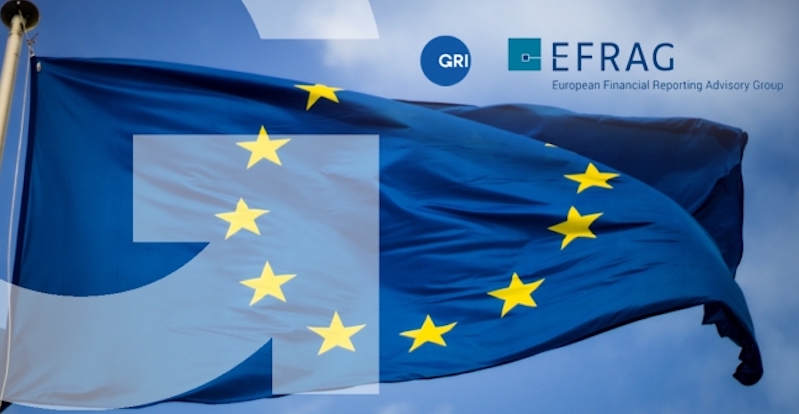
European Sustainability Reporting Standards (ESRS): a complete coverage of E, S and G disclosures under double materiality to support high-quality reporting
The successful integration of ESRS into the European legal framework marks a milestone in the progress of quality sustainability reporting in the Europe and globally. ESRS introduce a structured set of disclosures, designed to overcome the current lack of comparable, reliable and complete information and to bring sustainability and financial reporting on equal footing.
Developed following a transparent due process, ESRS are the result of EFRAG multi-stakeholder consensual decision-making. The European Commission further streamlined the EFRAG drafts and introduced substantial phasing-in provisions. This process allowed to achieve a proportionate balance between the need for comprehensive information by users and the necessity to avoid undue burden for companies.
ESRS set comprehensive disclosure requirements on cross-cutting aspects (such as strategy, business model and governance) and on ten different topics.
They articulate each topic in more detailed sustainability matters and provide disclosure requirements for each matter. The architecture of the environmental standards mirrors the objectives of the EU taxonomy (Climate, Pollution, Water and marine resources, Resource use and circular economy). The architecture of the social standards considers different groups of affected stakeholders (Own workforce, Workers in the value chain, Affected communities, Consumers and end-users). Finally, one standard covers business conduct. Cross-cutting standards define minimum disclosure requirements to report on policies, actions and targets (PAT), a key provision to avoid greenwashing. In addition, topical standards cover specific disclosure requirements on PAT and standardised metrics.
ESRS reporting considers three layers: sector-agnostic, sector-specific and entity-specific. The ESRS adopted in 2023 correspond to the sector-agnostic level, i.e. applicable to all the companies, irrespective of their sector. EFRAG will develop sector-ESRS guidance to support companies in reflecting the specificities of each sector. In addition, when a company concludes that an impact, risk or opportunity is not covered with sufficient granularity by ESRS, but is material due to the company’s specific facts and circumstances, it shall provide additional entity-specific disclosures, to enable users to understand the company’s impacts, risks or opportunities. Until the issuance of sector ESRS guidance, the entity-specific layer reflect sector-specificities, based on existing practices and other standards. The combination of the three layers enables the necessary level of relevance, capturing potential emerging issues that the standard setter couldn’t anticipate.
A key feature of ESRS is the double materiality: they cover impacts of the company on people and environment (impact materiality) and the financial risks and opportunities deriving to the company from sustainability issues (financial materiality). Users of ESRS sustainability statement are the investors, as well as others (such as trade unions, social partners, civil society). Conceptually the two perspectives differ, however in practice most material impacts will result in material financial risks and opportunities. As a result, investors need impact information. Similarly, stakeholders that are not investors, need financial information (next to impact information) to hold companies accountable for their impacts.
EFRAG constant policy is to contribute to the progress of corporate reporting globally and to avoid multiple reports for companies.
With the adoption of ESRS, Europe is the first jurisdiction in the world to incorporate IFRS sustainability disclosures, under a thorough interoperability approach. As EU entities prepare their sustainability statement in compliance with ESRS, they can be assured that they also provide information in line with the IFRS requirements in relation to climate change, without undue burden. Similarly, companies reporting under ESRS will be deemed reporting ‘with reference’ to the GRI Standards, without issuing a separate report. Furthermore, ESRS environmental standards are structurally compliant with the Framework recently issued by the Task Force on Nature-related Financial Disclosure and encourage best practices of that Framework. Finally, when considering the approach to impact reporting, ESRS refer to international instruments, such the UN Guiding Principles on Business and Human Rights and the OECD Guidelines for Multinational Enterprises.
At the same time, ESRS contribute to the coherence of other existing EU reporting obligations, such as Sustainable Finance Disclosure Regulation, Article 8 EU Taxonomy, Pillar 3. The indicators stemming from those reporting obligations have been incorporated in ESRS, without interfering with the underlying existing definitions and methodologies.
ESRS have been designed to substantially advance the digital usability of the reported information, overcoming the current limits of XBRL tagging of narrative disclosures. The structure of the ESRS combines principles-based and rules based standard setting. Each disclosure requirement has an objective and a detailed list of datapoints to be covered. If a company has in mind this structure when preparing the human-readable report, it will face lower efforts to digitalize it.
Currently, a substantial part of EFRAG activities focus on helping companies in their preparation to ESRS, with the issuance of implementation guidance and with a Q&A platform accessible on EFRAG website, to collect questions from those facing the challenges of preparing to report in compliance with ESRS. At the same time, EFRAG is working with priority on two standards for small and medium enterprises, to reduce the burden deriving from the data requests to which they are exposed, and support their access to finance.




